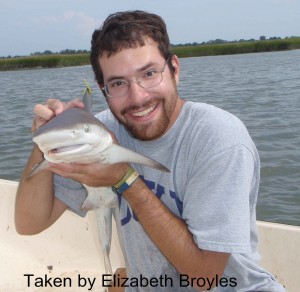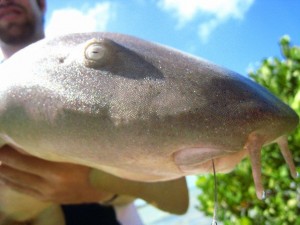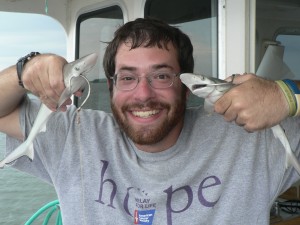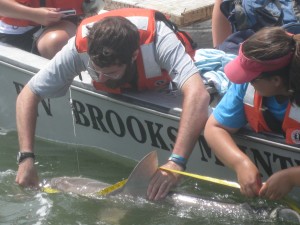 Three weeks ago, the South Carolina Department of Natural Resources COASTSPAN survey started it’s 2010 season. I was thrilled- it had been far too long since I was out on a boat catching sharks. The weather report looked good, and our scheduled sample site was only a few miles from where we set the DNR record for most sharks caught in a day (248). On paper, it looked like it was going to be a pretty good day. As it turned out, it was a great day. As we hauled in the first set of the first day of the season, something in the net caught my eye. Despite sampling in this exact location a dozen times before, despite years of working with sharks and two decades of loving sharks, we caught a species that I had never seen before. The smooth dogfish pup, only a few weeks old, made his species the fiftieth I have ever seen. In honor of this occasion, here is a brief excerpt from my upcoming shark conservation book, including pictures of me with some of the 50 species I’ve encountered. Enjoy!
Three weeks ago, the South Carolina Department of Natural Resources COASTSPAN survey started it’s 2010 season. I was thrilled- it had been far too long since I was out on a boat catching sharks. The weather report looked good, and our scheduled sample site was only a few miles from where we set the DNR record for most sharks caught in a day (248). On paper, it looked like it was going to be a pretty good day. As it turned out, it was a great day. As we hauled in the first set of the first day of the season, something in the net caught my eye. Despite sampling in this exact location a dozen times before, despite years of working with sharks and two decades of loving sharks, we caught a species that I had never seen before. The smooth dogfish pup, only a few weeks old, made his species the fiftieth I have ever seen. In honor of this occasion, here is a brief excerpt from my upcoming shark conservation book, including pictures of me with some of the 50 species I’ve encountered. Enjoy!
Introduction: What is a shark?
Before we discuss why sharks are important, what threats they are facing, and how you can help, I need to tell you a little bit about them. For those of you who don’t share my lifelong passion for these incredible animals, this section is required reading.

When most people think of sharks, they think of Great Whites, animals made infamous by the movie “Jaws”. Fishermen or Shark Week enthusiasts may be able to name a few more examples, but few are aware that sharks are a diverse group made up of over 400 species.

Sharks are found all over the world. They inhabit shallow coastal seas and parts of the ocean so deep that sunlight never reaches them. You can see sharks swimming around coral reefs near our tropical vacation destinations, or beneath the polar ice caps which few humans ever observe. Some, like the bull shark, can even live in fresh water.

Some, like the hammerhead, have peculiar shapes. Some are gray, some are brown, some have camouflage coloration, some glow in the dark, and in at least one case they can be bubble-gum pink!

More than half of all shark species are smaller than me when full grown, hardly the threat to swimmers that people visualize. An adult dwarf lanternshark is less than eight inches long. The world’s largest living fish, the whale shark, eats only microscopic plankton. Even though these animals are the size of a school bus, they pose no threat to us.

Some species spend their whole lives in a few square miles of ocean, while others swim around the globe. A sandbar shark that was tagged off the coast of Virginia was found in Italy years later, and a great white was tracked from South Africa to Australia over the course of a few months. A mako shark is one of the ocean’s fastest fish, but even someone as physically unfit as me can easily outswim a nurse shark. Finetooth sharks are adapted to eat crabs, while tiger sharks can eat anything (including license plates and a huge variety of other trash that people dump into the oceans). Bonnethead sharks are often found in schools of many thousands, but bull sharks are usually solitary.

Sharks and their close relatives (skates, rays, and chimaeras) are members of class Elasmobranchii, the cartilaginous fishes. Though they are a diverse group, they have many things in common other than their lack of bony skeletons. Almost all are relatively long-lived, and most have very few young at a time- a combination that makes them vulnerable to overfishing. Because of these life history traits and the economic value associated with some elasmobranch products, many are in serious danger of extinction. In the following pages, I hope to convince you that sharks matter, that many species are in big trouble, and, most importantly, that you can help them.
~WhySharksMatter
Smooth dogfish are rare in South Carolina? They’ve been one of the most common sharks I’ve seen in both Rhode Island and North Carolina.
They’re rare inshore this time of year. 98% of my sampling is inshore during the summer (because that’s when and where the sandbar sharks are)
Gotcha. I’ve usually seen smooths up near the ocean-side beaches in NC. I have read about them giving birth in salt ponds in Jersey. Good find, they’re one of my favorites.
Thanks for posting the intro! Very inspiring. Can’t wait for the whole book.